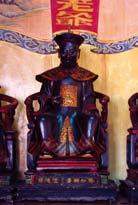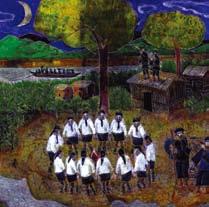In 1806, armed conflict broke out amongst the various ethnic immigrants, followed by pillaging by the pirates Cai Qian and Zhu Zi. The government subsequently realized that if they continued to disregard Kavalan and did not establish the rule of law and a system of defense, Yilan would become a haven for criminals and outlaws -- a thorn in the side for Taiwan. In 1809, the Jiaqing Emperor incorporated Kavalan into the domain of the empire. Troops were dispatched to quell pirate attacks and chart the local territory. Yang Tingli was also commissioned to set up a governing body in the region.
Yang Tingli dedicated the utmost efforts in order to observe the beliefs, customs and landscape of the region, completing "Constitution for the Founding of Kavalan" based on the idea of "Wuwei to the east, a land of appropriate size extending westward, a broad vista, clearly delineated mountainous ridges, bases for supervising administrative officials and patrolling personnel, and the building of city walls for defense." He chose Three-knot Street in Wuwei (modern day Yilan City) as the seat of the government, thus establishing Kavalan City.
Whilst Yang Tingli was organizing the establishment of Yilan, he was originally to be transferred elsewhere but was then ordered to stay in Kavalan as a local supervising administrative official. In August of 1812, this position was taken over by Zhai Gan on orders of the Qing administration. Zhai Gan picked up where Yang Tingli left off, and the two men worked together planning various administrative strategies and measures, eventually completing the monumental task of developing Kavalan.
Local government systems in Taiwan underwent many changes during the Qing period, but as for administrative levels lower than the county, and the even more local villages, there were no major changes. The earliest organization and planning of the Yilan district were based on the efforts of Yang Tingli and consisted of seven citadels. In 1835, the original seven citadels were further divided into twelve citadels based on the needs of the changing population and environment. This arrangement remained unchanged until the end of Qing Dynasty rule. Within this structure, Qing era Han territory in the Yilan district replaced only that of the original Pingpu tribe on the plains. In the mountains, however, conflicts of interest and in the process of development lead to sporadic clashes between the Han and the Atayal.
With respect to the Pingpu tribe, Yang Tingli initiated the policy of allotting reservations for settling aboriginal peoples during the Qing era. By the 1850s, this policy appeared to lose its effectiveness. Under increasing hardship and pressure to eke out a living, the Pingpu abandoned their homes and migrated to the mountainous regions or simply left permanently to settle down elsewhere.

